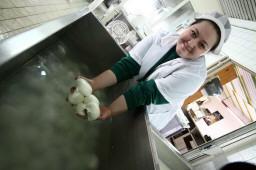These is no direct link between the Campania region's trash crisis and carcinogenic dioxins recently found in buffalo milk used for making Neapolitan mozzarella, an Italian health ministry official said on Wednesday.
''The dioxins found did not come from urban waste but from the burning of agricultural industrial waste or from tainted feed,'' according to Donato Greco, head of the health ministry's prevention department.
Greco's findings were later confirmed by Health Undersecretary Gian Paolo Patta who explained that the burning of the industrial waste apparently produced fine dioxin particles which were carried into the air by smoke and then settled on the gound.
According to Patta, the dioxin contamination of mozzarella cheese ''is limited and has been contained. The vast majority of herds producing (buffalo) milk in the area and the mozzarella produced are free from any contamination''.
Speaking on the sidelines of a summit at the health ministry with representatives from the Campania region, the agriculture, environment and foreign trade ministries, Patta added ''we hope to resolve the situation in a matter of days''.
''We will respond to all questions from those nations which have been alarmed over reports in the international press of mozzarella contamination,'' he added.
South Korea has temporarily banned mozzarella imports from Italy while Japan has seized four tonnes of the cheese as a precautionary measure.
Japan, which initially was reported to have imposed a ban on imports, said on Wednesday that the mozzarella seized had arrived by plane on Friday and was being tested.
Japanese officials told ANSA that mozzarella was still available in Japan and sales did not appear to be affected by any dioxin 'panic'. The European Commission said on Wednesday that it was expecting a report from Italy on the discovery of dioxins in buffalo milk mozzarella produced in Campania.
''If there is evidence of dioxin contamination we will decide what steps need to be taken. We are in close contact with Italian authorities,'' an EC spokesman said.
Speaking to the press at the health ministry, Patta explained that Neapolitan mozzarella was ''a healthy and very controlled product and the vast majority of the cheese produced is free of any dioxin contamination. I believe we can easily say that it is quite safe to eat''.
''The whole production chain is subject to controls also on the part of the private sector which is involved in every phase of production and distribution,'' he added.
''Thus there is no cause for any panic similar to the one that hit the poultry sector during the bird flu scare, which resulted in an 80% drop in sales despite Italian farms being free from infection,'' Patta said.
Although Italy has denied any direct link between urban trash and the dioxin contamination, the New York Times on Wednesday wrote that the scare may act as a stimulus to help resolve the Campania region's chronic trash crisis.
According to the NYT, ''the problem makes for a near-perfect morality play about modern Italy: For years, the paralysed political class has done little to halt huge-scale illegal dumping of trash, some of it toxic, around Naples. That area happens to produce some of the best mozzarella''. In order to avert any possible mozzarella panic, Agriculture Minister Paolo De Castro will hold a press conference on Thursday together with Campania region officials; the dean of the University of Naples' veterinary school, Luigi Zicarelli; and the chairman of the consortium of quality buffalo mozzarella makers, Franco Consalvo.
In a statement issued on Wednesday, De Castro said: ''On such a delicate issue it is important to be as clear and correct as possible in order not to penalise a whole sector and all those honest producers, who are the vast majority, who every day work to make a product which is a jewel in the crown of our quality food production''.
Some 16% of the quality buffalo mozzarella produced in the Naples area is exported for a value of around 48 million euros. Most of the exports are to European markets, with France and Germany accounting for 40% of all exports.
The United states is the third biggest importer followed by Britain, Japan and Switzerland.













